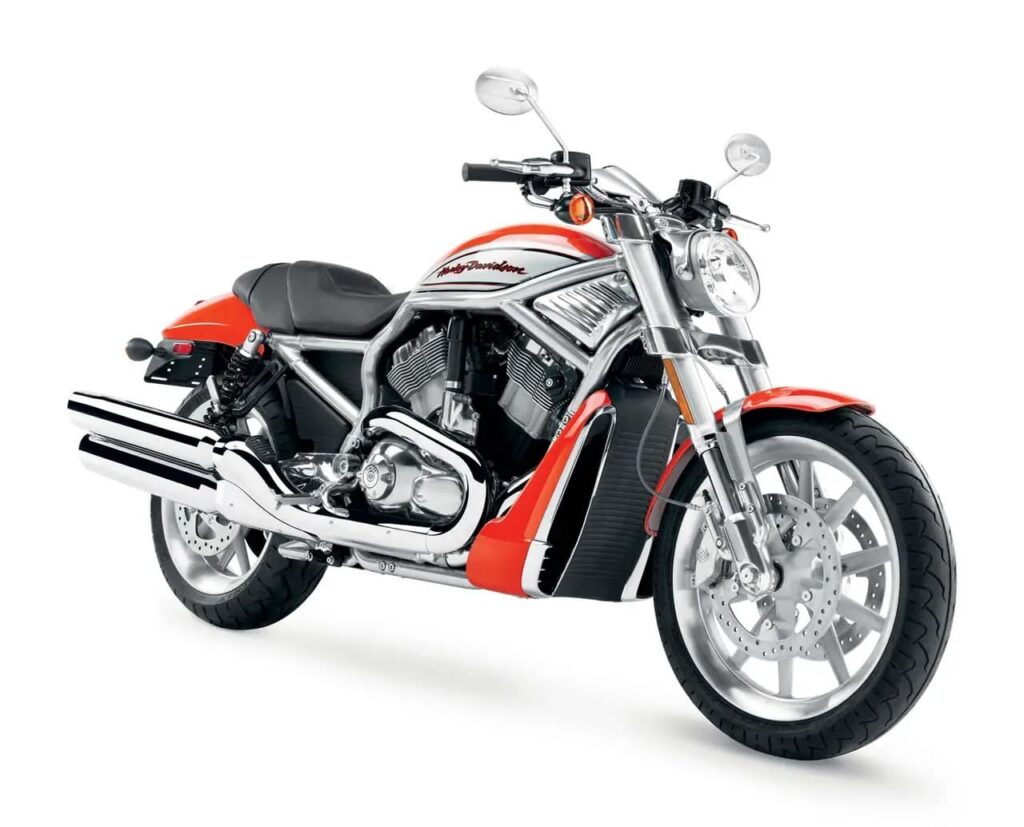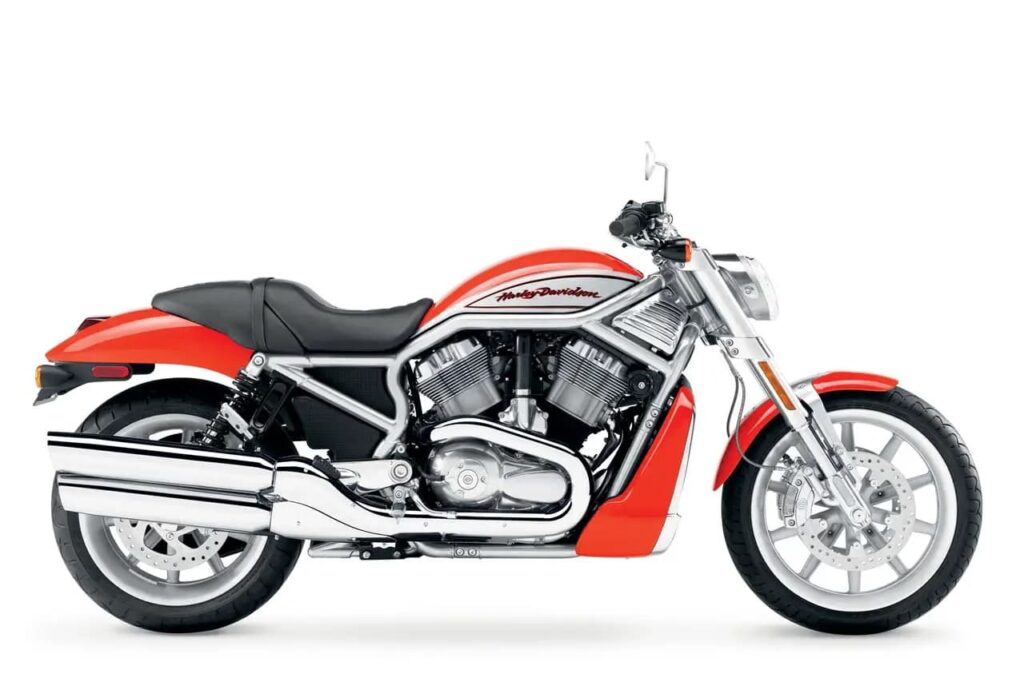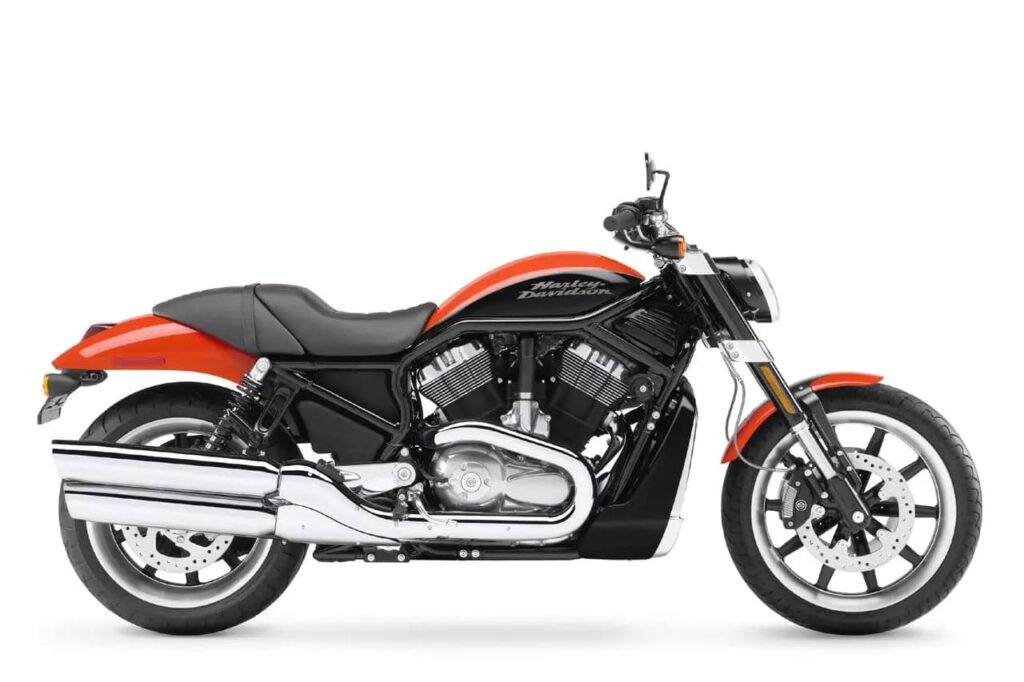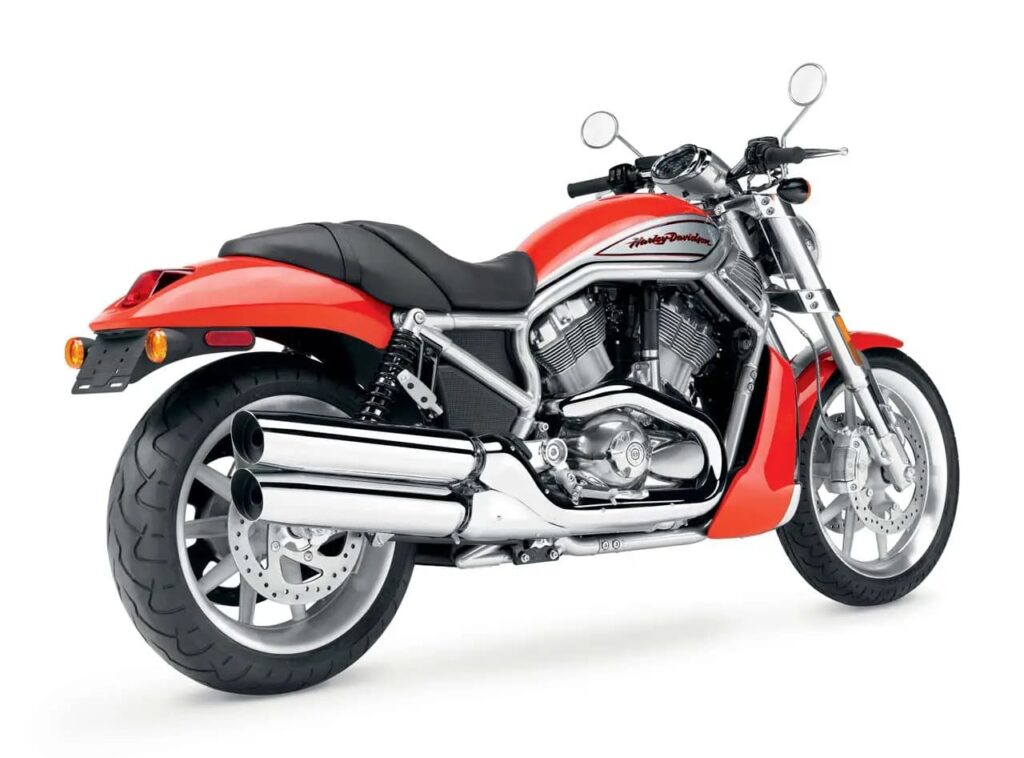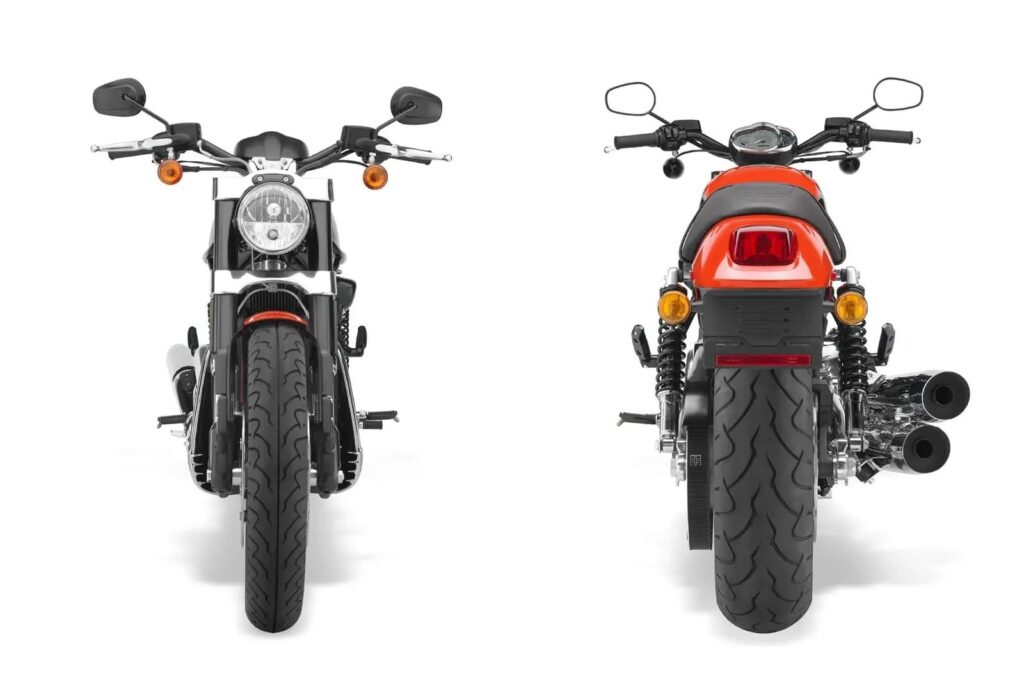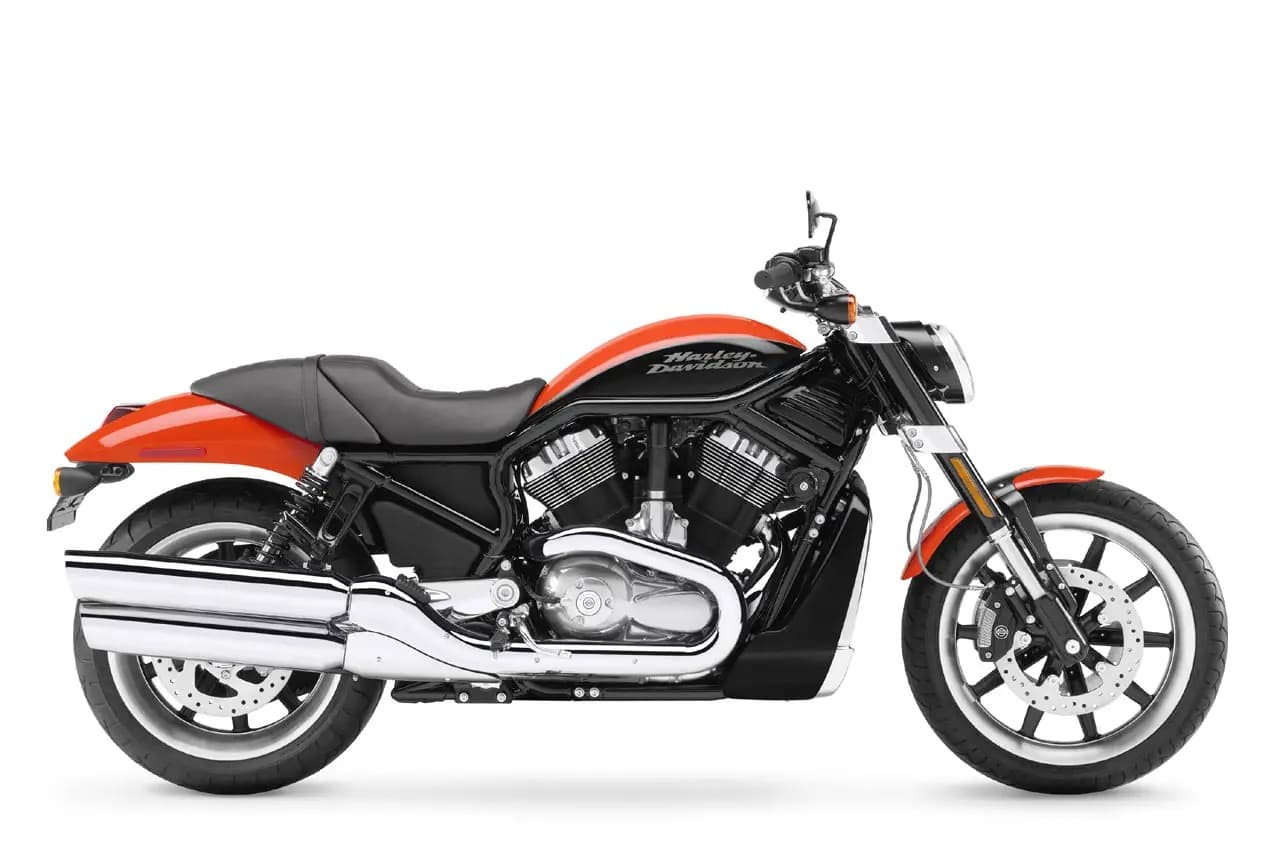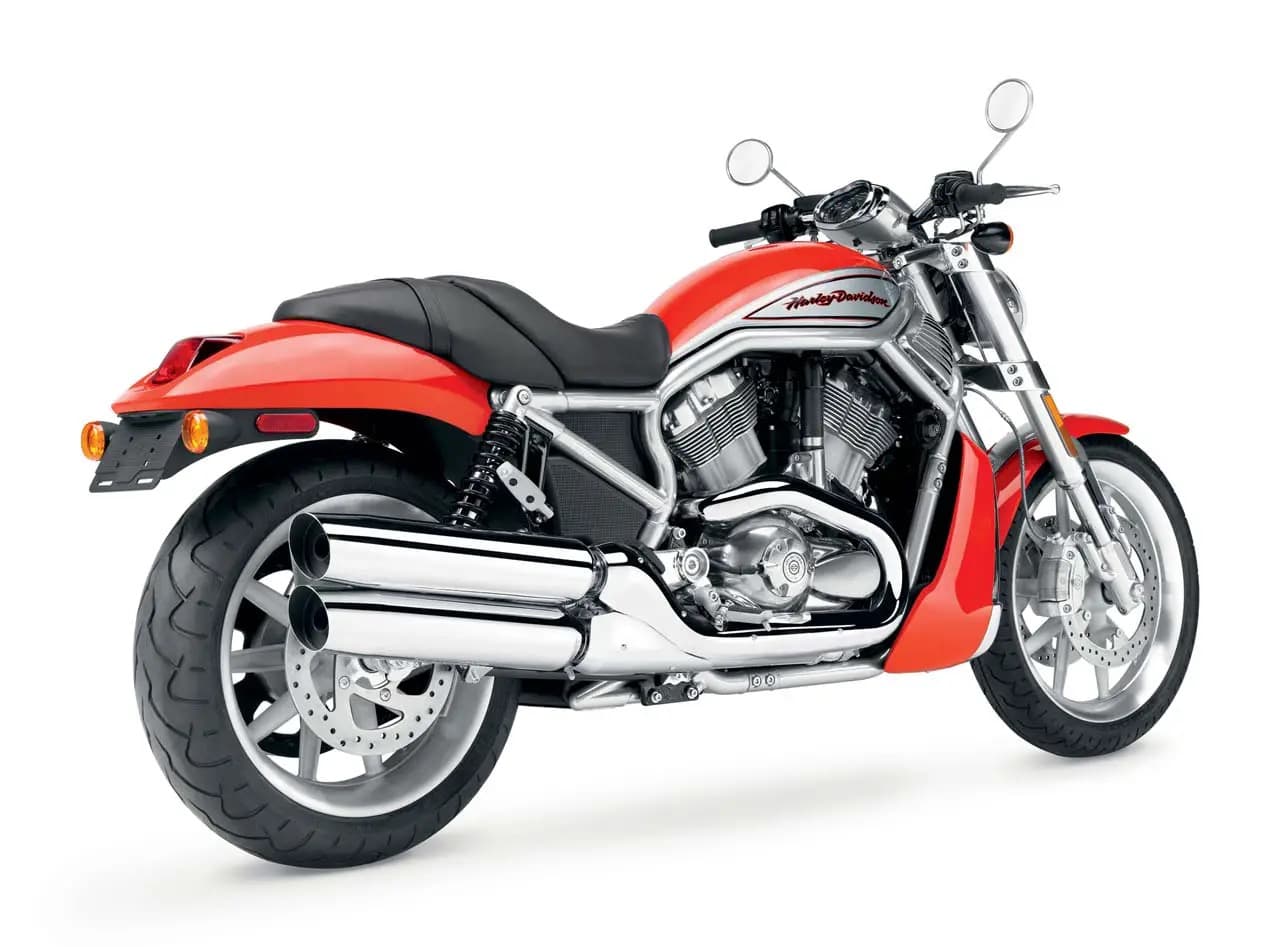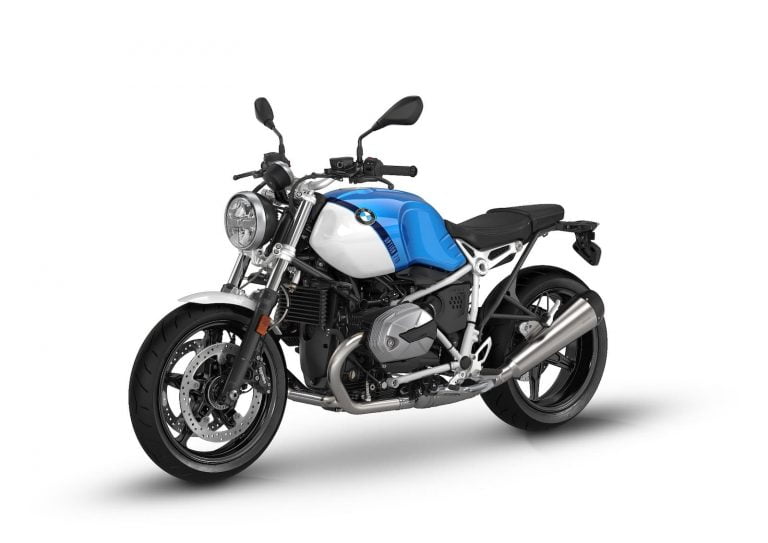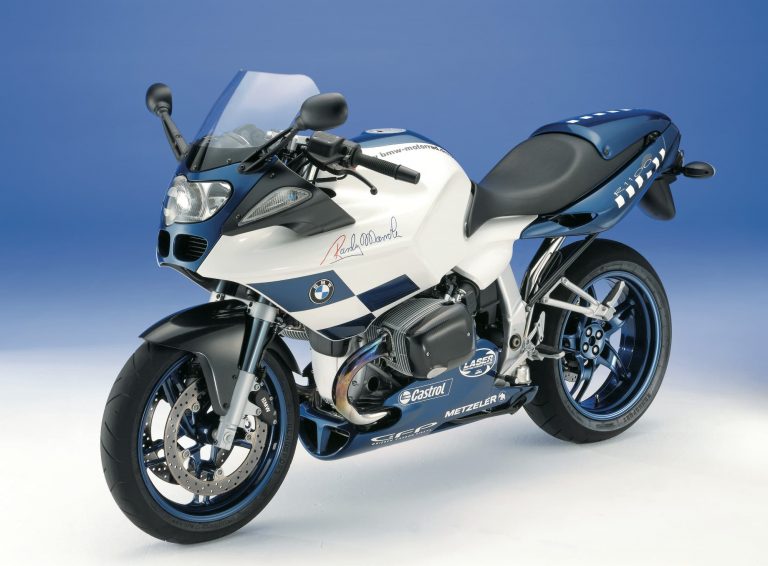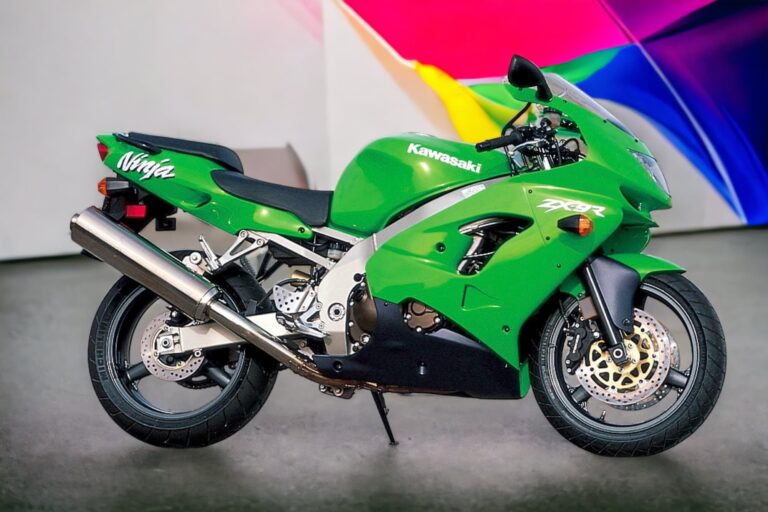Harley-Davidson VRSCR Street Rod (2006-2007) Maintenance Schedule and Service Intervals
This is the maintenance schedule and service intervals for the Harley-Davidson VRSCR Street Rod, the cruiser based on the VRSC V-Rod, but optimised more for sportier intentions.
While it shares a name with the much newer and very different XG750A Street Rod as well as the fact that the similarly-named engine (Revolution X, vs the VRSC’s Revolution) is liquid-cooled, the now classic VRSCR Street Rod is a very different cup of tea, with a high-power V-Rod engine in it.
The Harley-Davidson VRSCR Street Rod is powered by a 59 ci / 1130 cc liquid-cooled 60-degree V-twin with dual overhead cams and four valves per cylinder. With a sporty compression ratio of 11.3:1, it makes peak power of 89 kW / 121 hp at 7000 rpm, and peak torque of 80 lb-ft / 108 Nm at 7000 rpm, too.
Final drive is via a 5-speed transmission and a belt.
The VRSCR Street Rod is fairly unique in the Harley-Davidson line-up for shipping with factory mid-controls, and with decent enough clearance to actually lean, making this a great cruiser for sport bike riders.
This site has links from which we earn a commission (which unfortunately nobody can save, not even us). If you appreciate this research work, then please use those links. Thanks.
Harley-Davidson VRSCR Street Rod Service Intervals
Like most Harley-Davidson motorcycles, the Harley-Davidson VRSCR Street Rod has 5000 mile / 8000 km or annual service intervals.
At every service, change the oil and filter, and look over the motorcycle for items needing lubrication, adjustment, or cleaning. Also check wearable items (like hoses and tires) to see if they’re still in good condition.
Unlike many other Harley-Davidson motorcycles, the VRSCR Street Rod does not have self-adjusting hydraulic valves, and thus has a valve inspection interval. The original manual specified it as 10000 miles, but a service bulletin extended the valve service interval for the 1130 V-Rod motor to 15000 miles (see the screenshot below), and that’s what’s reflected below.
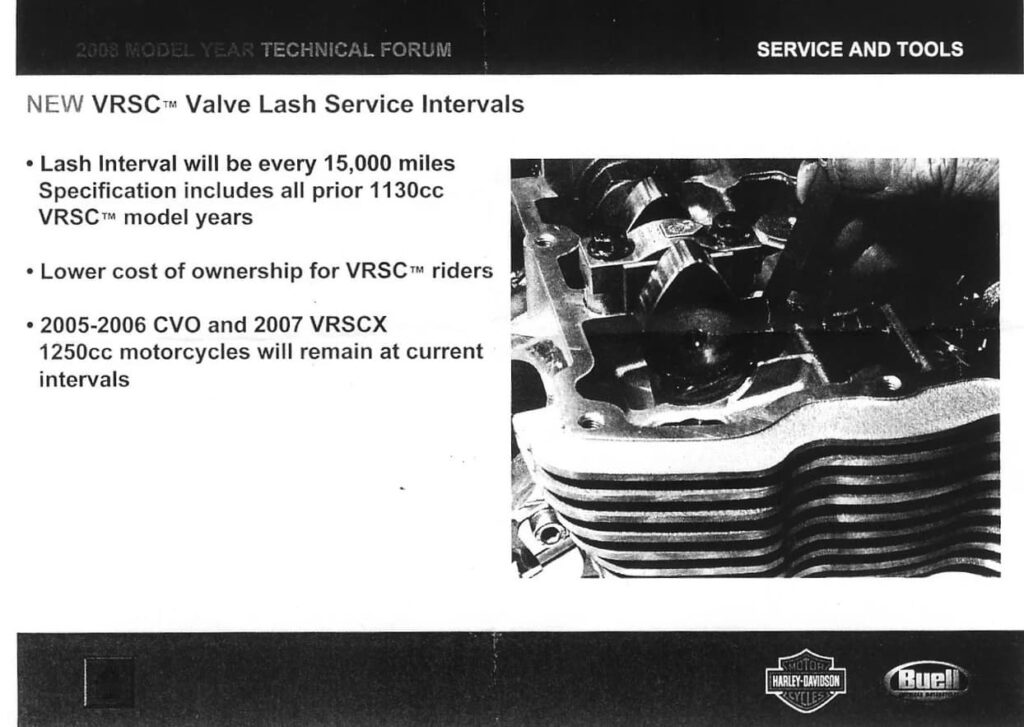
A number of items need to be done less frequently, like changing the brake fluid. See the schedule for more details.
Harley-Davidson VRSCR Street Rod Maintenance Schedule
Below is the maintenance schedule for the VRSCR Street Rod. It is split into two components:
- The core maintenance schedule of important items to service, and
- The inspection checklist to do at every scheduled service.
Maintenance schedule
Keep repeating this maintenance schedule in the pattern shown. Follow the earlier of time-based or distance-based service intervals, where appropriate.
| mi x 1000 | 5 | 10 | 15 | 20 | 25 | 30 | |
|---|---|---|---|---|---|---|---|
| km x 1000 | 8 | 16 | 24 | 32 | 40 | 48 | Every |
| Service checklist – Perform | ✓ | ✓ | ✓ | ✓ | ✓ | ✓ | Year |
| Engine oil and filter – Replace | ✓ | ✓ | ✓ | ✓ | ✓ | ✓ | |
| Spark plugs – Inspect | ✓ | ✓ | ✓ | ||||
| Spark plugs – Replace | ✓ | ✓ | ✓ | ||||
| Brake fluid – Replace | 2 years | ||||||
| Front fork oil – Replace | ✓ | ||||||
| Steering head bearings – Adjust – Disassemble, lubricate, and inspect | ✓ | 30K miles (48K km) after first service | |||||
| Rear fork bearings – Repack | ✓ | ||||||
| Valve lash – Inspect, Adjust | ✓ | ✓ | |||||
| Cooling system – Inspect; check clamps for tightness, check coolant freeze point | ✓ | ✓ | |||||
| Coolant – Replace | ✓ | ||||||
| Critical fasteners – Check tightness | ✓ | ✓ | 1 | ||||
| Battery – Check battery and clean connections | Year |
Service checklist
Below is the checklist of service items for the Harley-Davidson VRSCR Street Rod.
| Service Checklist — Harley-Davidson V-Rod 1130 |
|---|
| Drive belt and sprockets – Inspect and adjust belt |
| Air cleaner – Inspect, service as required |
| Oil lines and brake system – Inspect for leaks |
| Brake pads and discs – Inspect for wear |
| Brake fluid – Check levels and condition |
| Clutch fluid – Check level and condition |
| Throttle, brake and clutch controls – Check, adjust and lubricate |
| Tires – Check pressure, inspect tread |
| Radiator – Clean |
| Jiffy stand – Inspect and lubricate |
| Electrical equipment and switches – Check operation |
| Road test – Verify component and system functions |
VRSCR Belt Tension Adjustment
Like most (but not all) Harley-Davidsons, the VRSCR Street Rod has a belt final drive. While this is lower maintenance than a chain, you still have to check its condition and tension, adjusting tension and changing it if necessary.
Follow this procedure to check the Street Rod’s belt tension.
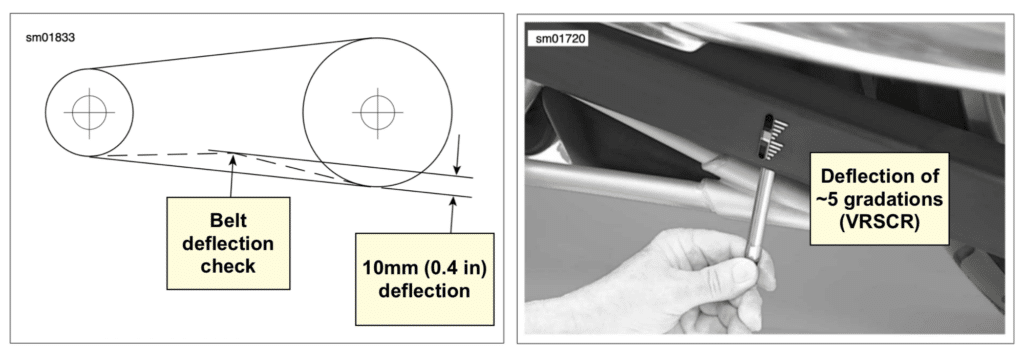
- Put the motorcycle in neutral with the motorcycle upright. (Not on its kickstand)
- Use a belt tension gauge to push up at the belt deflection measurement window.
- Measure the number of notches of deflection. Each deflection is 2mm.
Target deflection for the VRSCR: 10mm (other models have different deflection numbers).
If the belt slack is out of spec, you need to adjust it by following the below procedure.
- Remove the e-clip on the axle and loosen the rear axle. You’ll need a large breaker bar.
- Turn the axle adjustment eccentric on the left-hand side until the belt deflects 10mm.
- Tighten axle to 140-150 lb-ft (190-203 Nm) (Note — This may seem very high, but it’s true — see this discussion on 1130cc.com)
- Install e-clip
- Re-check belt deflection to make sure it hasn’t moved.
Notes on Valve Service for the VRSC Revolution Engines
The VRSC motorcycles have a Revolution series engine, which is of a totally different construction from other Harley-Davidson engines — different from the “Big Twins” and different from the Revolution X motors in the later Street like (e.g. the Street Rod XG750A).
The Revolution engine has mechanical valve lifters, not the self-adjusting hydraulic lifters that most Harley-Davidsons have (from Sportsters to Tourers). Thus, the valve clearances have to be set — every 15,000 miles or 24,000 km. The Revolution engine has a shim under bucket valve adjustment procedure.
The procedure to adjust the valve lash is roughly as complex as it is on most motorcycles with dual overhead camshafts. First, it greatly improves access to loosen the drive belt, remove or loosen the exhaust, remove some of the engine mounts, and tilt the engine forward.
You have to remove things around the valve covers and remove the valve covers. Some of the fasteners require special tools.
Then, you have to use feeler gauges to check the clearances of the valves. There are four valves per cylinder, so eight clearances to check.
Valve lash specs for the Revolution engine are below:
| Area | Valve lash (mm) | Valve lash (in) |
|---|---|---|
| Intake | 0.195-0.245 mm | 0.0078 – 0.0096 in |
| Exhaust | 0.295-0.345 mm | 0.0117 – 0.0135 in |
If the valve lash is out of spec, you have to then (without losing the timing) remove the cam chain tensioner, roll a camshaft out of the way, and remove the bucket, replacing the shim underneath it.
The valve lash adjustment procedure is delicate and easy to muck up if you accidentally knock off the timing chain or camshaft, so it’s good to have a mechanic you can call to fix the timing if that happens.
Wheels and Tire Pressures for the VRSCR Street Rod
The VRSCR Street Rod shipped with Dunlop D207 radial tires. Below are their sizes and recommended pressures.
| Wheel | Tire size | Tire pressure (cold) |
|---|---|---|
| Front | 120/70ZR19 60W | 36 psi / 248 kPa |
| Rear | 180/55ZR18 74W | Solo: 38 psi / 262 kPa 2-up: 40 psi / 276 kPa |
Note the VRSCR has a narrower-profile 180 tire, different from the later Night Rod Special.
About the 2006-2007 Harley-Davidson VRSCR Street Rod
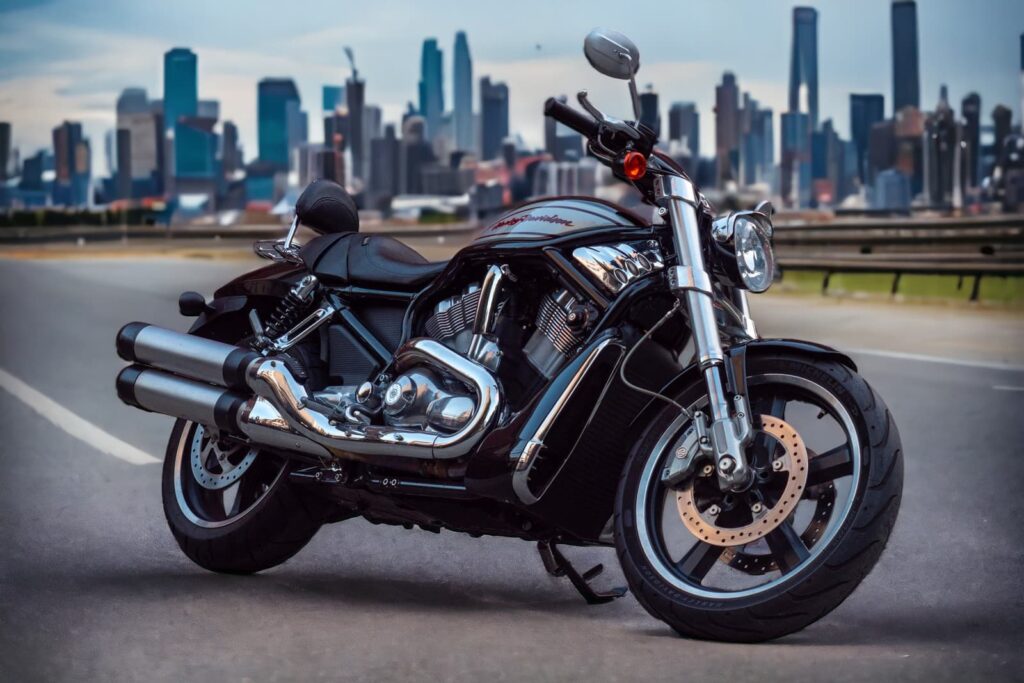
The Harley-Davidson VRSCR Street Rod is part of the early V-Rod series based on the 1130 engine.
There’s a lot that’s special and unique about the VRSCR Street Rod. But any description has to start with the engine, the now iconic Revolution V-Twin, a liquid-cooled 60-degree V-twin with dual overhead camshafts and four valves per cylinder. It’s tuned for actual power — not just torque — and peaks at 89 kW / 121 hp at 7000 rpm, with a redline at 9000 rpm. And remember, this is in a cruiser!
Unlike the vast majority of Harley-Davidson motorcycles, the VRSCR Street Rod has an upright seating position with controls that are described as mid-mount, but which are actually more like standard sport bike rear sets. The result is a “relaxed sport bike” rider triangle that has more in common with standard sport bikes (like the Suzuki Bandit GSF1200 of the time) than it does with any cruiser.
Below is an image of several concurrently sold VRSC models.
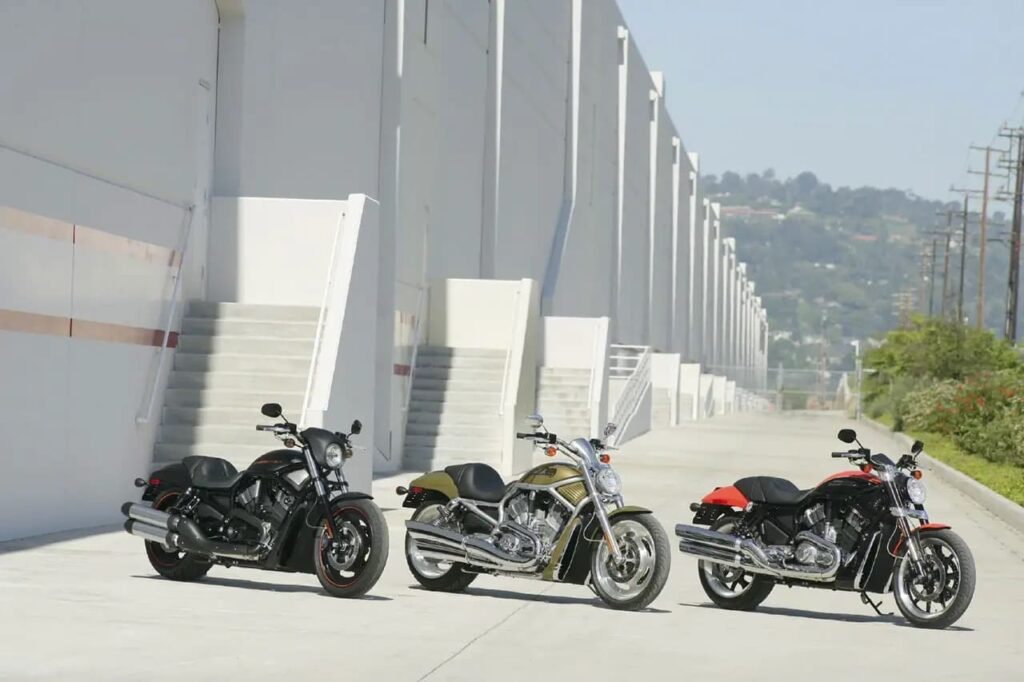
The change in riding position radically transforms the VRSCR Street Rod from a laid-back (but powerful) cruiser into a street brawler.
Harley-Davidson didn’t just change the riding position on the Street Rod. They tuned the motor (albeit mildly), pulling out an extra five horsepower. They also changed the suspension to make it much sharper, tightening up steering rake from 34 degrees to 30 degrees, reducing the fork angle from 38 degrees to 32 degrees, and implementing a Showa 43mm inverted cartridge fork, a first for Harley-Davidson.
Harley-Davidson also extended the rear shocks, and the net result is an impressive 40 degrees of lean angle vs the V-Rod’s 32. It’s a significant difference that means that you have to work the bike a lot harder before you get anywhere near scraping pegs.
There’s not much adjustability in the suspension, of course, with only preload adjustability in the rear shocks.
Brakes are high-spec for a cruiser, too, with twin 300mm discs up front and Brembo 4-piston calipers. (Twin discs on middleweight cruisers is a rarity.)
The net result of all the changes is that the Harley-Davidson VRSCR Street Rod is legitimately sporty. It was always a blast to wind on the throttle of the original V-Rod 1130. But the Street Rod is fun to fling around corners, too, despite the weight of the thing (it’s still no lightweight, being just shy of 300 kg or slightly over 650 lbs… anyway, much heavier than most muscle bikes).
The Harley-Davidson VRSCR Street Rod is a rare species of bike, one that most manufacturers no longer make. The best modern parallel still in production decades later would be the Ducati Diavel, which Ducati continued to iterate on over time. But Harley-Davidson cut the Street Rod’s reign short after two years.
Reference — Owner’s Manual for the Harley-Davidson VRSCR Street Rod
Below are screenshots as a reference for the maintenance schedule for the Harley-Davidson VRSCR Street Rod.
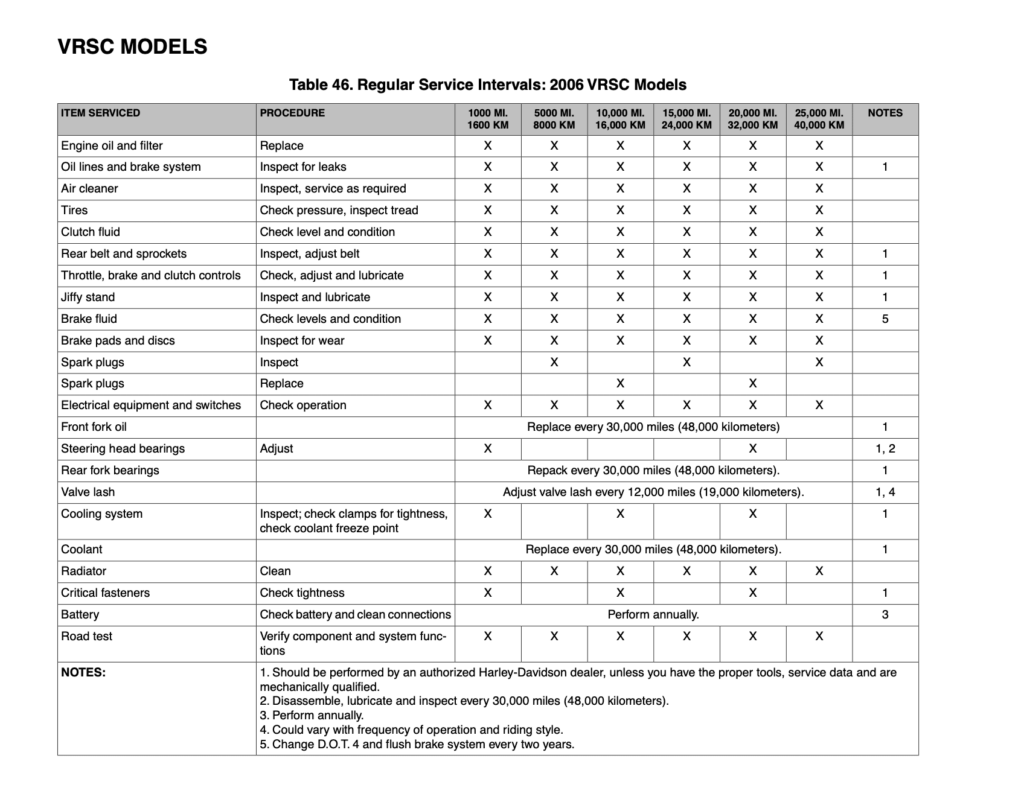
You can get the owner’s manual online here.
